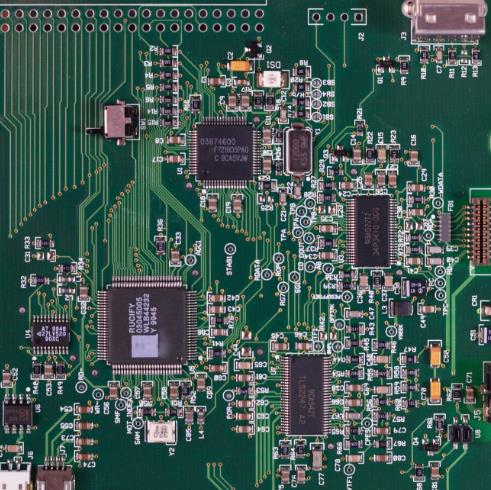In the study of high-speed PCB design, there are many knowledge points that need to be understood and mastered, such as common signal integrity, reflection, crosstalk, power noise, filtering and so on. This article will share 10 important knowledge related to high-speed PCB design with you, hoping to help you learn.
Signal integrity
Signal integrity (SI) refers to the quality of the Signal along the transmission path, which can be ordinary metal wire, optical devices, or other media.
A simple conductor can faithfully transmit signals over short distances and at low bit rates.

However, if a long-distance, high-bit-rate signal passes through several different conductors, multiple effects can reduce the reliability of the signal, so that the system or equipment can not work properly.
With the increase of output switching speed of integrated circuit and PCB density, signal integrity has become one of the problems that must be concerned in high-speed digital PCB design.
Parameters of components and PCB board, layout of components on PCB board, wiring of high-speed signal and other factors will cause signal integrity problems, resulting in unstable operation of the system, or even not working at all.
Signal integrity concerns mainly include ringing, crosstalk, grounding bounce, skew, signal loss and noise in power supply.
reflection
Reflection is an echo on a transmission line. Some of the signal power (voltage and current) is transmitted to the line and reaches the load, but some is reflected.
If the source and the load have the same impedance, reflection will not occur. A mismatch in impedance between the source and the load leads to on-line reflection, with the load reflecting part of the voltage back to the source.
If the load impedance is less than the source impedance, the reflected voltage is negative, and vice versa, if the load impedance is greater than the source impedance, the reflected voltage is positive.
Variations in wiring geometry, incorrect wire terminations, transmission through connectors, and discontinuities in the power plane can cause such reflections.
crosstalk
Crosstalk is the coupling between two signal lines. The mutual inductance and tolerance between signal lines cause the noise on the line.
Capacitive coupling leads to coupled current, whereas inductive coupling leads to coupled voltage. The parameters of PCB board layer, the distance between signal lines, the electrical characteristics of driving end and receiving end and the connection mode of line all have certain influence on crosstalk.
The characteristic impedance
To clarify a few concepts, we often see impedance, characteristic impedance, instantaneous impedance, strictly speaking, they are different, but all the same, they are still the basic definition of impedance:
The input impedance of the beginning of the transmission line is referred to as impedance;
The instantaneous impedance that the signal encounters at any time is called instantaneous impedance.
If the transmission line has a constant instantaneous impedance, it is called the characteristic impedance of the transmission line.
Characteristic impedance describes the transient impedance of a signal as it travels along a transmission line, which is a major factor affecting signal integrity in a transmission line circuit.
Unless otherwise specified, the characteristic impedance is generally referred to as the transmission line impedance.
PS: For high-speed PCB designs, our goal is to keep the impedance as stable as possible during signal transmission, which must keep the ch
aracteristic impedance of the transmission line stable.
Power integrity
Power Integrity (PI) is used to check whether the voltage and current at the source and destination of the Power supply meet requirements.
Power integrity is very important in today's electronic products. There are several levels of power integrity: the chip level, the chip package level, the board level, and the system level.
Among them, the power supply integrity at the board level should meet the following three requirements:
Make the voltage ripple of the chip pin smaller than the specification (e.g. the error between voltage and 1V is less than +/-50 mV)
Control grounding rebound (also known as synchronous switching noise SSN, synchronous switching output SSO)
Reduce electromagnetic interference (EMI) and maintain electromagnetic compatibility (EMC) : The Power distribution network (PDN) is a circuit board type conductor and therefore an antenna that is easy to transmit and receive noise.
The power supply noise
Power noise is a kind of electromagnetic interference, and its transmitted noise spectrum is roughly 10kHz~30MHz, up to 150MHz.
Power supply noise, especially transient noise interference, its rising speed, short duration, high voltage vibration amplitude, ran
domness is strong, microcomputer and digital electrical louie produce serious interference.
In high frequency circuits, the noise of power supply has an obvious effect on the high frequency signal. Therefore, the first requirement of the power supply is low noise. Clean floors are as important here as clean electricity.
The filter
Wave filtering is the operation to filter out the specific band frequency of signal, and it is an important measure to suppress and prevent interference.
Parallel bus
A bus is a shared physical channel for communication between two or more devices. It is a collection of signal cables and a common connection between multiple components. It is used to transmit information between components.
Bus can be divided into two types: one is parallel bus, the other is serial bus.
Parallel bus: multiple data can be transmitted at the same time, like a wide road that allows multiple cars to drive side by side, and it has a two-way one-way division.
Serial bus
Serial bus: only one data can be transmitted at a time, like a narrow road that allows only one car to travel. Data must be transmitted one after another, which looks like a long data string, so it is called serial.
Topology
Topology refers to the form in which each site is connected to each other in the network. Topology in PCB design refers to the connection relationship between chips.
Common topologies include point-to-point, Daisy chain, remote cluster, star, etc.